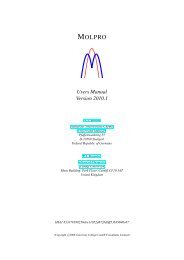Carbon−Carbon Coupling Reactions Catalyzed by Heterogeneous ...
Carbon−Carbon Coupling Reactions Catalyzed by Heterogeneous ...
Carbon−Carbon Coupling Reactions Catalyzed by Heterogeneous ...
Create successful ePaper yourself
Turn your PDF publications into a flip-book with our unique Google optimized e-Paper software.
<strong>Heterogeneous</strong> Pd <strong>Catalyzed</strong> C−C <strong>Coupling</strong> <strong>Reactions</strong> Chemical Reviews, 2007, Vol. 107, No. 1 161<br />
Table 64. Fukuyama <strong>Coupling</strong> Reaction in the Presence of<br />
Pd(OH)2/C<br />
cinnamates 167. 200 AsPh3 was superior to PPh3 as ligand<br />
(Table 65), and the �-halide was attacked selectively.<br />
6. Ullmann-Type <strong>Coupling</strong> <strong>Reactions</strong><br />
yield a (%)<br />
R<br />
Pd catalyst<br />
(mol %) T (h) Pd(OH)2/C Pd/C<br />
4-MeOPh(CH2)2 0.15 50 84 30<br />
CH3(CH2)6 0.6 24 93 52<br />
cyclohexyl 0.6 72 79 41<br />
EtO2C(CH2)6 0.9 17 78 67<br />
PhCO(CH2)2 0.9 23 70 50<br />
Ph 0.9 71 72 39<br />
3-Cl-Ph 0.6 25 73 25<br />
3-thienyl 0.9 68 61 19<br />
a Isolated yield.<br />
Table 65. Pd/C-<strong>Catalyzed</strong> Negishi <strong>Reactions</strong><br />
a Isolated yield. In entry 1, PPh3 was used; in entries 2-5, AsPh3<br />
was used.<br />
The Ullmann-type reaction, that is, homocoupling of aryl<br />
or vinyl halides is conventionally mediated <strong>by</strong> copper at high<br />
temperatures. In recent years, Pd/C-catalyzed Ullmann-type<br />
coupling in the presence of reducing reagents, such as sodium<br />
formate, hydrogen, zinc, indium, or triethylamine has attracted<br />
increasing attention.<br />
6.1. Pd/C-<strong>Catalyzed</strong> Aryl−Aryl <strong>Coupling</strong><br />
As found <strong>by</strong> Bamfield and co-workers201 in 1978, biaryls<br />
169 can be obtained in modest yields from chloro- or<br />
bromoarenes in the presence of Pd/C and a surfactant in<br />
aqueous alkaline sodium formate as a reducing agent<br />
(Scheme 48).<br />
Kinetics and mechanism of the reaction was investigated<br />
<strong>by</strong> Sasson et al. suggesting a single electron transfer (SET)<br />
process from Pd(0) to the chloroarene forming chloroarene<br />
radical anions. 202 Working in a two-phase system under<br />
phase-transfer catalysis conditions helped to increase the<br />
yield (Scheme 49). 203 The Pd/C catalyst was recycled without<br />
Scheme 48. Pd/C-<strong>Catalyzed</strong> Aryl-Aryl <strong>Coupling</strong> in the<br />
Presence of a Surfactant and HCO2Na<br />
losing its catalytic activity simply <strong>by</strong> filtration and washing<br />
with methanol.<br />
Scheme 49. Pd/C-<strong>Catalyzed</strong> Homocoupling of<br />
Chlorobenzene<br />
Excellent yields of biaryls 169 were achieved in an oilin-water<br />
microemulsion. 203,204 These results demonstrate that<br />
many industrially important substituted biaryls may be<br />
amenable to synthesis in very high yields <strong>by</strong> simply<br />
modifying the solvent assemblage (Table 66). 204<br />
Table 66. Ullmann-Type <strong>Coupling</strong> of Haloarenes in<br />
Microemulsion a<br />
entry<br />
microemulsion<br />
water/oil haloarene<br />
t<br />
(h)<br />
conv<br />
(%)<br />
select.<br />
(%)<br />
Ar-Ar<br />
select.<br />
(%)<br />
Ar-H<br />
1 O/W PhCl 3.5 100 92 8<br />
2 O/W PhBr 3.5 100 94 6<br />
3 O/W PhI 3.5 100 98 2<br />
4 O/W 4-Me-Ph-Cl 6 83 89 11<br />
5 O/W 4-CHO-Ph-Cl 5 92 92 8<br />
6 b O/W PhCl 22 92 53 47<br />
7 W/O PhCl 5.5 100 31 69<br />
8 none c PhCl 4 100 54 46<br />
a Reaction conditions: haloaryl (0.013 mol); 5% Pd/C (1 g); TBAB<br />
(1 g); sodium formate (1.5 g); NaOH (1.5 g); 75 °C. b No TBAB was<br />
used. c Water was used as solvent.<br />
Hydrogen was used as reducing reagent in Pd/C-catalyzed<br />
Ullmann-type coupling of various chlorobenzenes and bromobenzene<br />
to biaryls 169 in the presence of aqueous sodium<br />
hydroxide and a small amount of PEG-400 (Table 67). 205<br />
Arenes 171 formed <strong>by</strong> simple reduction of the halobenzenes<br />
were observed as <strong>by</strong>products to various extents. The Pd/C<br />
catalyst could be recycled simply <strong>by</strong> filtration and washing<br />
with water and methanol. After seven runs, the catalyst<br />
retained >99% of its activity.<br />
Zinc could also be used as reducing reagent in Pd/Ccatalyzed<br />
aryl-aryl coupling of haloarenes in aqueous<br />
sodium hydroxide in the presence of PEG-400, 206 in aqueous<br />
acetone without an additional base under mild convenient<br />
conditions (air, RT), 207 or in water in the presence of crown<br />
ethers. 208 Although high yields were achieved, only iodoand<br />
bromoarenes could be used in the latter method (Table<br />
68). 207<br />
In contrast, Pd/C-catalyzed zinc-mediated Ullmann-type<br />
coupling could be implemented with a variety of halides<br />
including chlorobenzenes when the reaction was carried out<br />
under carbon dioxide (Table 69). 209,210<br />
Indium as reducing agent in Pd/C-catalyzed aryl-aryl<br />
coupling of aryl and pyridyl iodides provided high yields.<br />
Short reaction times were sufficient with DMF as solvent<br />
and LiCl as additive (Table 70). 211 Aldehyde, keto, and<br />
thioether groups were tolerated in the aryl iodide components.












![Hetero [6+3] Cycloaddition of Fulvenes with N-Alkylidene Glycine ...](https://img.yumpu.com/35423358/1/190x245/hetero-6-3-cycloaddition-of-fulvenes-with-n-alkylidene-glycine-.jpg?quality=85)




